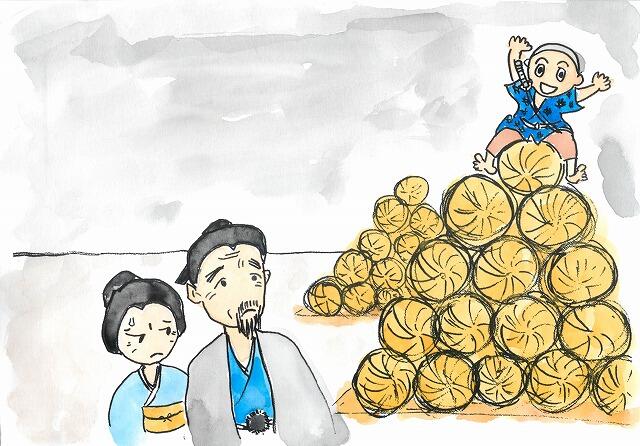The Story of Furukawa Taishirō
In 1848 (the first year of the Kaei era), Gōdai Gohei was born into the Gōdai family, who ran a rice and vegetable shop called Harimaya, in Horikawa, Osaka.
The family was well-off, and young Gohei often played with the sacks of rice at home and attended a terakoya (an old-style school). He was especially good at arithmetic and was quick at calculations, which always impressed his father.

In 1863 (the third year of the Bunkyū era), when Gohei was sixteen, he fell ill with an eye disease. The illness spread to his three younger siblings, but while they eventually recovered, Gohei's condition worsened. By the time he recovered the following year, he had lost his sight in both eyes. In 1866 (the second year of the Keio era), his younger brother Otokichi was born.
In 1869 (the second year of the Meiji era), Gohei's father died of illness. At the age of twenty-two, Gohei succeeded him as the fifth head of the Gōdai family.
However, business at Harimaya declined -- both the rice and vegetable trade disappeared -- and the family fell into hardship.
To support his family of seven, Gohei took on various jobs: he worked as an amma (massage therapist), a shūsen'ya (broker or go-between), sold rabbits, and bought and sold houses and land.
At that time, schools for blind or deaf children existed in Kyoto and Tokyo, but not in Osaka.
The Kyoto School for the Blind and Deaf (Kyoto Mōain) had been founded in 1878 (the eleventh year of Meiji) by Furukawa Taishirō -- the first such school in Japan.
When Gohei was forty-four, he began thinking about founding a similar school in Osaka for children who were blind or deaf.
In 1899 (the thirty-second year of Meiji), at the age of fifty-two, Gohei visited the Kyoto School for the Blind and Deaf with his thirty-four-year-old brother Otokichi. There, he met Dr. Furukawa himself and attended one of his lectures.
Inspired by Furukawa's words and achievements, Gohei resolved to establish a similar school in Osaka.
Gohei and his brother Otokichi drew up plans for a school for blind and deaf children in Osaka. In February 1900 (the thirty-third year of Meiji), they submitted the proposal to the Osaka Prefectural Government.
A month later, official approval was granted, and on September 13, 1900, within the grounds of the temple Jōkyū-ji, the Private Osaka School for the Blind and Deaf (Shiritsu Ōsaka Mōain) was opened.
The new school began with 25 students -- three blind and twenty-two deaf children. The number of pupils grew steadily, and within three years there were more than 130.
The children adored Gohei. He always walked with a gentle smile, leading them by the hand, and everyone would greet him warmly. Despite his blindness, Gohei helped wherever he could -- shaving dried bonito for the evening meal and assisting with daily needs -- contributing wholeheartedly to the school.
Because Gohei himself could not teach, he asked Dr. Furukawa to become the school's director (principal). Moved by Gohei's passion, Furukawa accepted the position. Together with two other teachers, they taught blind children subjects such as Japanese, arithmetic, massage, acupuncture, and music, while deaf children learned Japanese, arithmetic, physical education, crafts, sculpture, and sewing.
Gohei tirelessly traveled around Osaka from early morning until late at night, bowing and asking for donations to fund the school's operations.
Although many people donated, raising enough money every year was a constant struggle. As he grew older, Gohei became increasingly anxious about the school's future after his death.
In 1904 (the thirty-seventh year of Meiji), he made a difficult decision: to transfer the school he had founded to the City of Osaka, ensuring its continuation.
After repeated discussions in the city council, the transfer was approved, and in April 1907 (the fortieth year of Meiji), the school became the Osaka Municipal School for the Blind and Deaf (Shiritsu Ōsaka Mōagakkō). Gohei rejoiced, knowing that the school would endure.
Even after losing his sight, Gōdai Gohei worked tirelessly for his family and for the creation of a school for blind and deaf children in Osaka.
Dr. Furukawa Taishirō, who became the school's first principal, devoted himself to teaching the children.
The Private Osaka School for the Blind and Deaf, founded in 1900, changed its name several times over the years -- to Osaka Municipal School for the Blind and Deaf, Osaka City School for the Blind and Deaf, Osaka City School for the Deaf, Osaka City Deaf School, Osaka City School for the Hearing-Impaired, and finally Osaka Prefectural Central School for the Hearing-Impaired -- but it continues to this day.
Thanks to Gōdai Gohei, Dr. Furukawa Taishirō, and the many people who supported them, children today can still enjoy learning in a school for the deaf filled with their spirit, belief, and love.
This school will forever carry on their legacy and compassion.
Source:
"The Biography of Gōdai Gohei and Furukawa Taishirō," published by Osaka City School for the Deaf, 2016.
